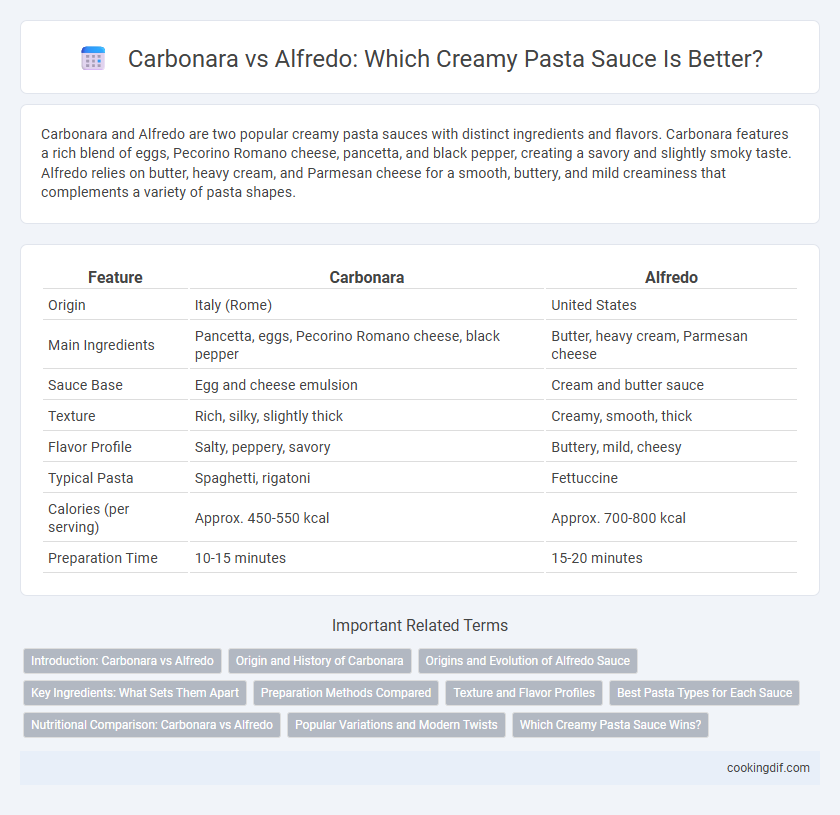Carbonara and Alfredo are two popular creamy pasta sauces with distinct ingredients and flavors. Carbonara features a rich blend of eggs, Pecorino Romano cheese, pancetta, and black pepper, creating a savory and slightly smoky taste. Alfredo relies on butter, heavy cream, and Parmesan cheese for a smooth, buttery, and mild creaminess that complements a variety of pasta shapes.
Table of Comparison
| Feature | Carbonara | Alfredo |
|---|---|---|
| Origin | Italy (Rome) | United States |
| Main Ingredients | Pancetta, eggs, Pecorino Romano cheese, black pepper | Butter, heavy cream, Parmesan cheese |
| Sauce Base | Egg and cheese emulsion | Cream and butter sauce |
| Texture | Rich, silky, slightly thick | Creamy, smooth, thick |
| Flavor Profile | Salty, peppery, savory | Buttery, mild, cheesy |
| Typical Pasta | Spaghetti, rigatoni | Fettuccine |
| Calories (per serving) | Approx. 450-550 kcal | Approx. 700-800 kcal |
| Preparation Time | 10-15 minutes | 15-20 minutes |
Introduction: Carbonara vs Alfredo
Carbonara and Alfredo represent two iconic Italian-inspired creamy pasta sauces with distinct ingredients and flavors. Carbonara is traditionally made with eggs, Pecorino Romano cheese, guanciale, and black pepper, creating a rich yet savory sauce. Alfredo combines butter, heavy cream, and Parmesan cheese, resulting in a smooth, velvety texture that emphasizes creamy indulgence.
Origin and History of Carbonara
Carbonara originated in Rome during the mid-20th century, traditionally made with eggs, Pecorino Romano cheese, guanciale, and black pepper to create its creamy texture without cream. Alfredo sauce, by contrast, was invented in early 20th-century Italy but gained fame in the United States, known for its rich cream, butter, and Parmesan cheese blend. The authentic carbonara's creamy sauce relies on the emulsification of eggs and cheese, preserving its Italian heritage and distinct flavor profile.
Origins and Evolution of Alfredo Sauce
Alfredo sauce originated in early 20th-century Rome, created by restaurateur Alfredo di Lelio as a simple blend of butter, Parmesan cheese, and pasta water, designed to help his wife regain strength after childbirth. This creamy sauce evolved in the United States into a richer version incorporating heavy cream, garlic, and sometimes chicken or mushrooms, differentiating it significantly from its original Italian form and from Carbonara's egg-based creamy texture. While Carbonara emphasizes pancetta and eggs for a silky sauce, Alfredo relies on dairy fats for its creamy consistency, reflecting distinct culinary traditions and ingredient availability.
Key Ingredients: What Sets Them Apart
Carbonara and Alfredo sauces differ primarily in their key ingredients, defining their distinct creaminess and flavor profiles. Carbonara uses eggs, Pecorino Romano cheese, pancetta, and black pepper, creating a rich, silky texture without any cream. Alfredo features butter, heavy cream, and Parmesan cheese, delivering a smooth, velvety sauce with a milder, buttery taste.
Preparation Methods Compared
Carbonara relies on a traditional Roman method combining raw eggs, pecorino Romano cheese, guanciale, and freshly ground black pepper, which creates a creamy texture through the heat of the pasta rather than cream. Alfredo sauce, originating from Italian-American cuisine, uses heavy cream, butter, and Parmesan cheese, resulting in a richer, more uniformly creamy sauce achieved by emulsifying dairy ingredients over low heat. The key difference lies in Carbonara's use of eggs for emulsification versus Alfredo's reliance on dairy fats, influencing both flavor complexity and mouthfeel.
Texture and Flavor Profiles
Carbonara features a silky, velvety texture achieved through emulsified egg yolks and cheese, offering a savory, smoky flavor profile often enhanced by pancetta or guanciale. Alfredo sauce boasts a rich, creamy consistency created by butter and heavy cream, delivering a mild, buttery taste with Parmesan's subtle sharpness. Both sauces provide distinct creamy experiences, with Carbonara emphasizing depth and complexity, while Alfredo highlights smoothness and richness.
Best Pasta Types for Each Sauce
Fettuccine is the classic choice for Alfredo sauce, as its wide, flat shape holds the rich, creamy bechamel-based sauce effectively. For Carbonara, spaghetti is preferred because its thin strands allow the silky egg, cheese, and pancetta mixture to coat evenly, creating a balanced texture and flavor. Penne and rigatoni also work well with Alfredo due to their ridges, while bucatini can enhance Carbonara by adding a slight bite and more surface area for sauce adherence.
Nutritional Comparison: Carbonara vs Alfredo
Carbonara typically contains eggs, pancetta, and cheese, providing a higher protein content and moderate fat levels compared to Alfredo, which relies heavily on butter and heavy cream, resulting in higher saturated fat and calorie counts. The carbohydrate content remains similar in both sauces when paired with traditional pasta, but Alfredo generally has more calories per serving due to its rich dairy base. For those seeking a protein-rich option with fewer calories and less saturated fat, Carbonara presents a more balanced nutritional profile than Alfredo.
Popular Variations and Modern Twists
Carbonara traditionally combines eggs, Pecorino Romano, guanciale, and black pepper, creating a rich yet simple creamy sauce without heavy cream, while Alfredo sauce relies on butter and Parmesan for its smooth, indulgent texture. Popular variations of Carbonara include the addition of peas or mushrooms, and modern twists often incorporate cream or substitute pancetta for guanciale, adapting the recipe for contemporary palates. Alfredo has evolved with versions that mix garlic, cream, and herbs, often served with chicken or shrimp to enhance the classic creamy profile.
Which Creamy Pasta Sauce Wins?
Carbonara and Alfredo represent two iconic creamy pasta sauces distinguished by their ingredients and flavor profiles. Carbonara combines eggs, Pecorino Romano cheese, guanciale, and black pepper to create a rich yet balanced sauce with a slightly smoky, savory taste. Alfredo, made from butter, heavy cream, and Parmesan cheese, offers a luxuriously smooth and buttery texture but can be heavier and less complex in flavor compared to the sharp, tangy, and umami-rich notes found in Carbonara.
Carbonara vs Alfredo for creamy sauce Infographic

 cookingdif.com
cookingdif.com